Kaleidoscope of divine order: explore how the number 24 in the Bible unveils mysteries of authority and time, beckoning deeper insight.
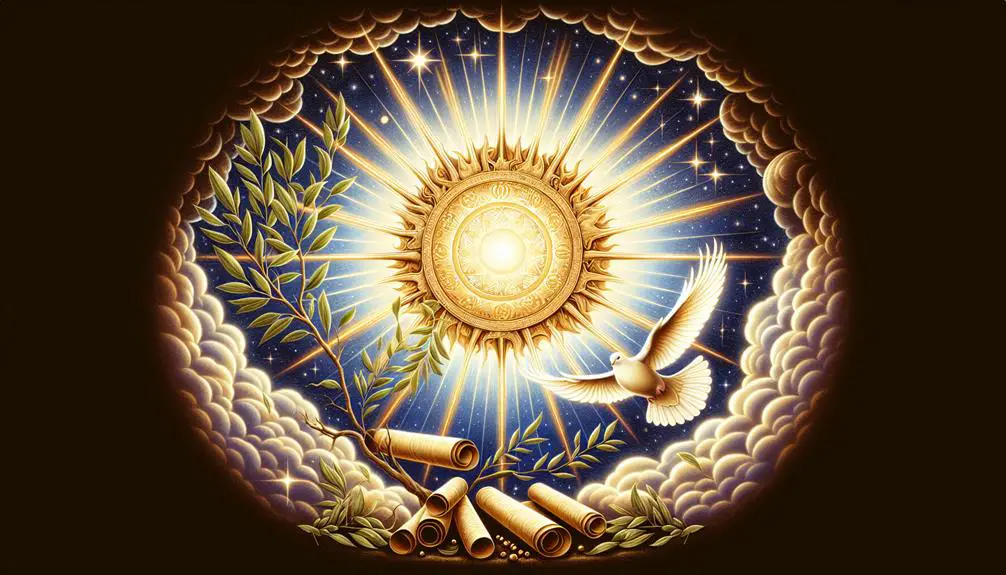
Significance of the Number 24 in the Bible
In the intricate tapestry of biblical numerology, the number 24 emerges with a compelling presence, manifesting not only in the enigmatic assembly of the 24 elders in the Book of Revelation but also in the structure of priestly divisions and David's musical arrangements as delineated in Chronicles.
This number, evocative of cosmic order and divine governance, intersects with profound themes of priesthood, authority, and the very cyclical nature of time itself. As we examine these dimensions, one cannot help but ponder the deeper implications of the number 24 in reflecting divine authority and its meticulously designed representation within the biblical narrative.
Key Takeaways
- The number 24 symbolizes cosmic order and divine governance, as seen with the 24 elders in Revelation.
- It reflects structured divine organization in worship, through priestly divisions and musical arrangements.
- Symbolizes divine authority and harmony, intertwining with temporal structures like the 24-hour day and celestial patterns.
- Represents spiritual mediation and divine appointment, highlighting the structured role of priests as intermediaries between God and humanity.
The 24 Elders in Revelation
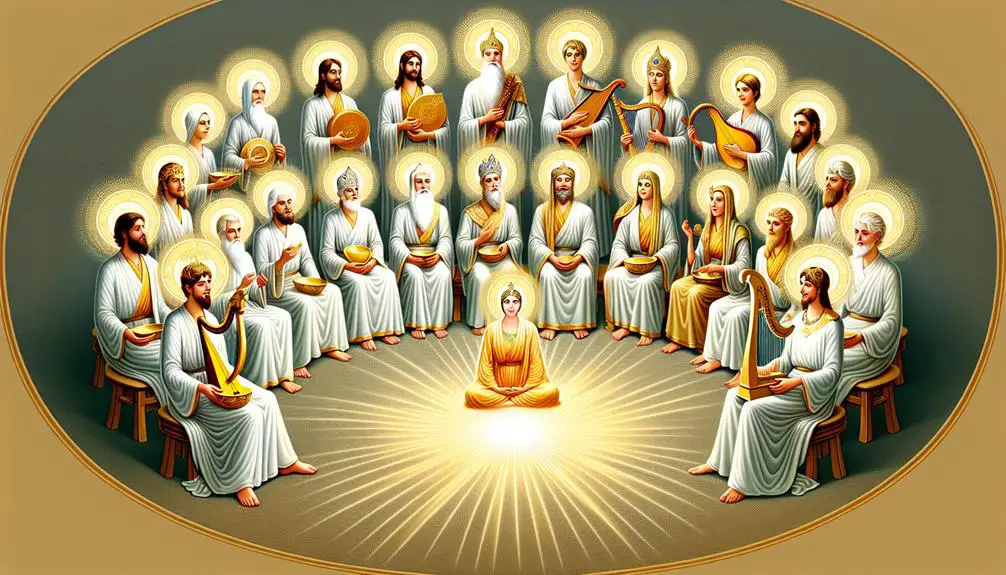
One of the most intriguing aspects of the Book of Revelation is its depiction of the 24 Elders, who embody a significant, albeit enigmatic, element of the celestial hierarchy. This group, shrouded in mystery, serves as an elderly representation within the apocalyptic imagery that pervades the text. Their presence, seated on thrones surrounding the throne of God, symbolizes authority and wisdom, traits traditionally associated with advanced age in many cultures. The number 24 itself may hold symbolic meaning, potentially representing a completeness or a divine governmental structure in the heavenly realm.
The Elders are described as wearing white garments and golden crowns, signifying purity and sovereignty, respectively. These attributes contribute to the rich tapestry of symbolism that Revelation employs to convey its message. The act of casting their crowns before the throne of God signifies their submission and acknowledgment of God's supreme authority, a theme central to the book's overarching narrative.
The role of the Elders in the celestial hierarchy is multifaceted. They appear to function as intermediaries, participating in the worship of God and executing divine judgments. Their inclusion in the apocalyptic imagery of Revelation suggests a connection between the heavenly and the earthly, possibly implying that they represent the redeemed of humanity or a specific priestly order. This allegorical interpretation highlights the intricate relationship between the divine and the mortal, a recurrent theme throughout biblical literature.
Priestly Divisions in Chronicles
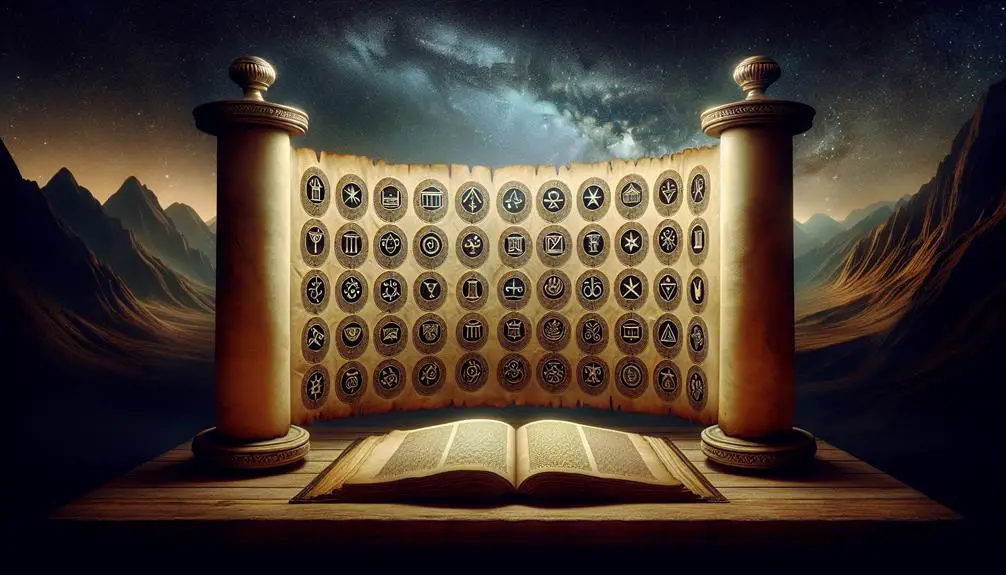
In the Chronicles, the delineation of priestly divisions emerges as a critical component of the Israelite religious structure, reflecting a meticulously organized system of worship and service. This organization, as prescribed in the Chronicles, is not merely a testament to order but serves as a bridge between the sacred genealogies of the past and the operational realities of temple service. It underscores the genealogy significance, not only highlighting the hereditary aspect of the priesthood but also marking the continuance of tribal roles within a sacred context.
The division into 24 priestly groups signifies a structured approach to managing the temple's duties, ensuring a continuous service to God without overburdening any single group. This system mirrors the broader Biblical theme of order and organization underpinning the universe, as seen through the lens of Israelite religious practice. The allocation of roles within these divisions underscores the importance of every tribe's contribution to the spiritual wellbeing of the community, emphasizing the collective responsibility towards worship and adherence to divine statutes.
The following table exemplifies some of the divisions and their corresponding leaders, illustrating the depth of organization and the varied tribal representation:
Division Number |
Leader |
Tribal Affiliation |
|---|---|---|
1 |
Jehoiarib |
Levi |
2 |
Jedaiah |
Levi |
3 |
Harim |
Levi |
4 |
Seorim |
Levi |
This structure not only facilitated the practical aspects of temple service but also reinforced the spiritual and communal unity among the Israelites, with each division playing a pivotal role in the collective expression of faith and adherence to divine commandments.
David's Musical Arrangements
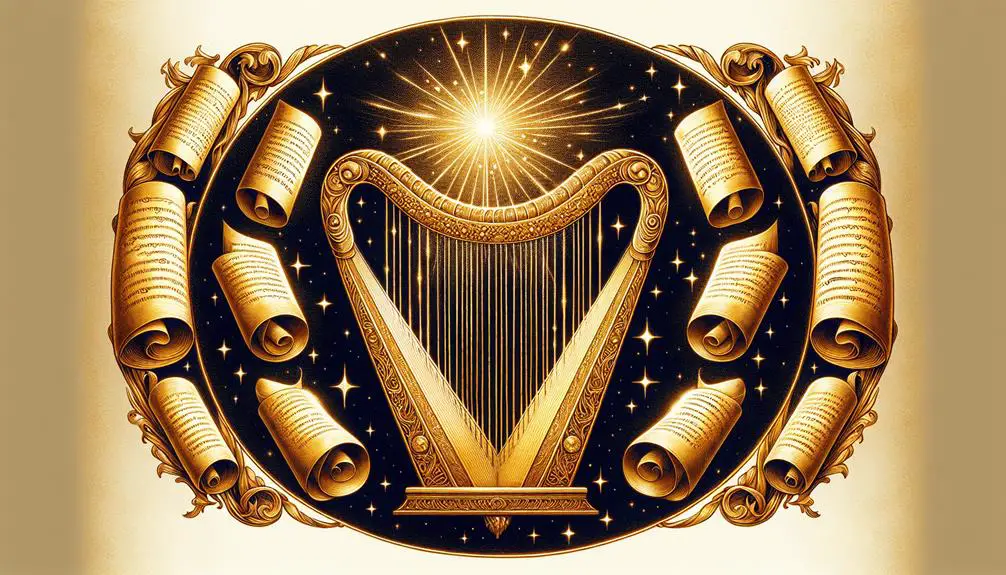
In examining the biblical account of David's Musical Arrangements, a pivotal aspect to consider is the structured organization of the Levitical choirs. This arrangement, along with the criteria for selecting musical instruments, was instrumental in shaping the worship service structure within the ancient Israelite religious practices.
These elements collectively underscore the intricate relationship between numerical symbolism and liturgical order in the Hebrew Scriptures.
Levitical Choir Organization
King David's establishment of the Levitical choir, as documented in the Scriptures, represents a significant evolution in the liturgical music tradition within ancient Israelite worship practices. This organizational innovation was not merely administrative but deeply spiritual, aiming to enhance the worship experience through structured vocalization and presentation.
Central to this evolution was the emphasis on vocal training, ensuring that the Levites could deliver hymns and psalms with skill and reverence, elevating the communal worship experience. Equally important was the introduction of choir uniforms, which served to unify the participants visually and symbolically, reinforcing their role as intermediaries between the congregation and the divine.
This meticulous organization underscored the solemnity and sanctity of the worship service, setting a precedent for religious musical practices in subsequent generations.
Instrument Selection Criteria
Building upon the established foundation of the Levitical choir, David's musical arrangements further refined worship practices through meticulous instrument selection criteria. This approach was not arbitrary but deeply rooted in the principles of material durability and user compatibility, ensuring the instruments not only lasted but also complemented the skills of the Levitical musicians.
Criteria |
Instrument Example |
Justification |
|---|---|---|
Material Durability |
Harp |
Resistant to wear, ensuring longevity in service |
User Compatibility |
Lyre |
Easily adaptable to the musician's skill level |
Acoustic Quality |
Trumpet |
Capable of producing clear, penetrating sounds ideal for sacred spaces |
Such criteria underscored an analytical framework that balanced tradition with the need for adaptability, setting a precedent for worship practices that resonated deeply within the spiritual fabric of the time.
Worship Service Structure
David's innovative musical arrangements for worship services introduced a structured approach that harmonized sacred music with liturgical acts, marking a significant evolution in the spiritual experience of the congregation. His meticulous organization of service timing and delineation of congregational roles fostered a communal rhythm that deeply resonated with attendees.
- The precision in service timing ensured a seamless flow, enhancing spiritual contemplation.
- Congregational roles were clearly defined, promoting unity and participation.
- Music and liturgy interwove, creating an immersive atmosphere of worship.
- The emotional depth of services was amplified, touching the hearts of the faithful.
David's arrangements thus not only structured the worship service but also elevated it, weaving together the threads of music, liturgy, and community into a rich tapestry of divine communion.
Symbolism of Priesthood
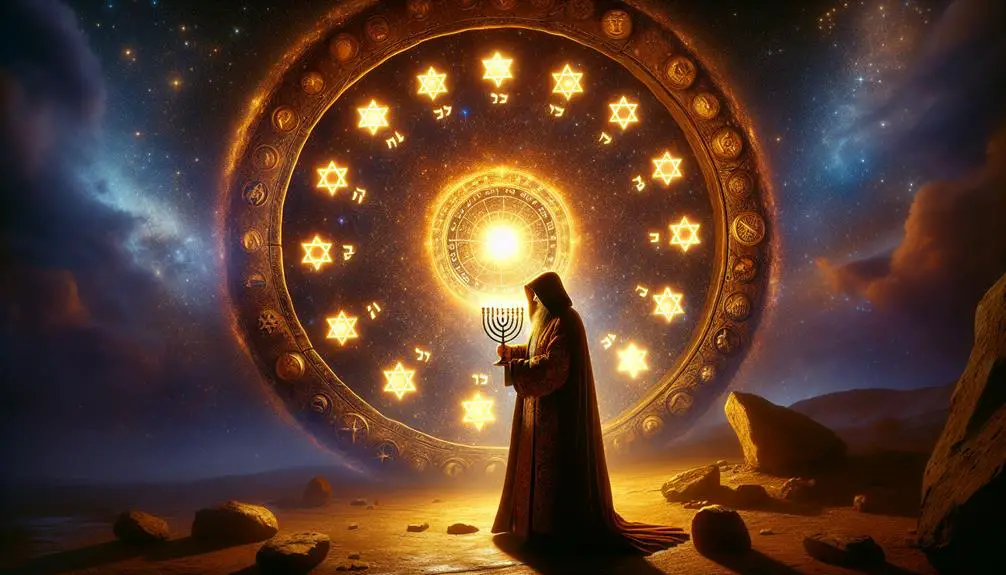
The number 24 holds significant symbolic relevance to the concept of priesthood within biblical scripture, serving as a representation of the organized structure and divine appointment of priestly roles. This numerical symbolism is deeply intertwined with the Aaronic lineage and the performance of sacrificial rites, both central to the Old Testament's depiction of spiritual mediation between God and His people. The structured organization of the priesthood, as delineated in the scriptures, reflects a divine order and meticulous planning that aligns with the broader themes of governance and sanctity found throughout the Bible.
Aspect |
Description |
Biblical Reference |
|---|---|---|
Aaronic Lineage |
Represents the hereditary line of priests originating from Aaron. |
Exodus 28:1 |
Sacrificial Rites |
Essential ceremonies for atonement and worship. |
Leviticus 1:1-17 |
Divine Appointment |
Indicates the selection of priests by God's explicit command. |
Numbers 18:7 |
Organized Structure |
The orderly arrangement of priestly duties and roles. |
1 Chronicles 24:1-19 |
Spiritual Mediation |
The role of priests as intermediaries between God and humanity. |
Hebrews 5:1 |
The organization into 24 divisions, as seen in the service of the Temple, underscores the emphasis on orderly worship and the comprehensive coverage of priestly duties. This division not only facilitated a continuous service but also symbolized a complete and perpetual dedication to God, reflecting the infinite nature of His presence and the ceaseless devotion He desires from His followers. This structured approach to priesthood highlights the importance of order, reverence, and solemnity in the practice of faith and worship.
Cosmic Order and Government
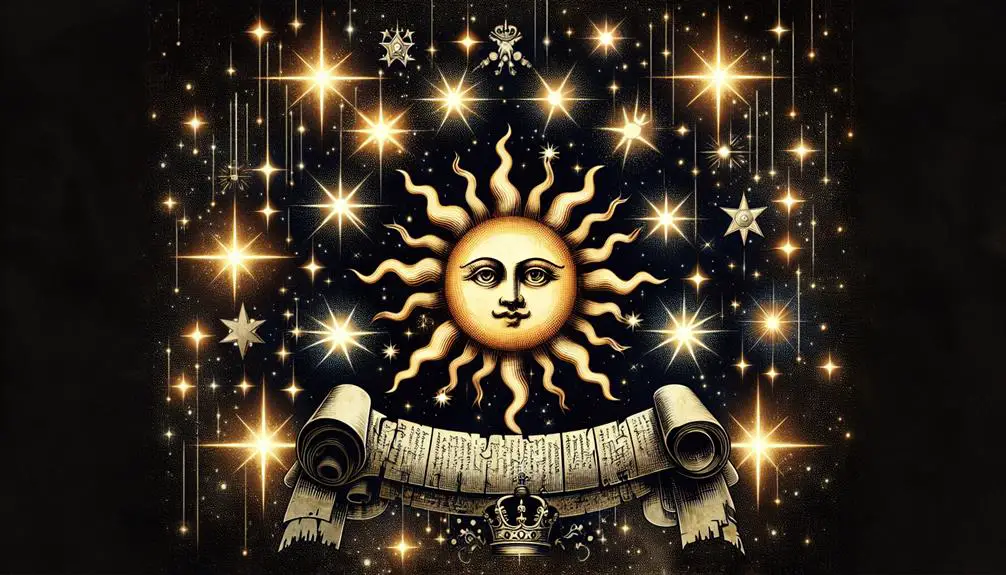
In biblical scripture, the number 24 also symbolizes cosmic order and divine governance, reflecting a heavenly blueprint that influences earthly realms. This concept of cosmic order is deeply intertwined with the idea of universal harmony and the meticulous design of astronomical patterns. Such symbolic significance of the number 24 extends beyond the literal text, offering a metaphorical lens through which to view the structure of the cosmos and its governance by divine decree.
The inclusion of 24 elders around the throne in the book of Revelation serves as a vivid illustration of this cosmic order, suggesting a heavenly court that mirrors the order and governance expected within the earthly realm. This imagery not only reinforces the connection between the divine and the terrestrial but also emphasizes the meticulous balance maintained in the universe, as ordained by God.
- Astronomical patterns, reflecting the precision and constancy of celestial movements, echo the divine order.
- Universal harmony emerges from this celestial choreography, suggesting a cosmos governed by divine laws.
- The interplay between heavenly bodies, governed by precise rules, mirrors the structured governance of the universe.
- This cosmic order, represented by the number 24, underscores the unity and interconnectedness of all creation, pointing toward a divine architect.
Analyzing the number 24 within the context of cosmic order and government in biblical scripture, therefore, opens up a rich tapestry of meaning. It reveals a universe created with intentionality and governed by a divine will, aiming for harmony and balance both in the celestial and terrestrial realms.
The Time Cycle: Hours and Days

Exploring further, the number 24 not only holds significance in the context of cosmic order and divine governance but also manifests profoundly in the temporal structures of hours and days, underpinning the rhythm of human life and natural cycles. The division of the day into 24 hours is a universally accepted system, reflecting not just a convenient time-keeping method, but also a deeper, symbolic resonance with the divine harmonies observed within the scriptures. This subdivision into 24 units facilitates the alignment of daily human activities with the celestial patterns, indicating a divine imprint in the very fabric of time.
The embedding of the number 24 within the cycle of hours and days extends its significance beyond the mere measurement of time, intertwining with the seasonal rhythms and lunar cycles that dictate the ebb and flow of life on Earth. This dual representation of divine order in both the heavens and the temporal realm underscores the omnipresence of divine principles in the natural world.
To emphasize the interconnectedness between the number 24, daily time cycles, and broader cosmic rhythms, consider the following table:
Aspect |
Significance of 24 |
Connection |
|---|---|---|
Daily Hours |
24 hours in a day |
Temporal Structure |
Seasonal Cycles |
4 seasons x 6 months |
Seasonal Rhythms |
Lunar Phases |
Approx. 24 days |
Lunar Cycles |
This table succinctly encapsulates how the number 24 serves as a nexus between the temporal cycles of days, the broader patterns of seasonal change, and the cycles of the moon, highlighting its profound symbolic and practical importance in structuring both time and divine natural order.
Reflections of Divine Authority

Delving into biblical narratives, it becomes evident that the number 24 frequently mirrors divine authority and governance, serving as a symbol deeply embedded within the fabric of sacred texts. This numerical symbolism is not arbitrary but is intricately linked with the broader theological motifs that span the biblical canon, particularly those associated with the angelic hierarchy and the concept of sacred numbers, which convey profound spiritual truths.
The number 24 is prominently featured in the Book of Revelation, where it describes 24 elders seated around the throne of God. This imagery is rich in symbolism and represents a structured divine order. The elders are often interpreted as reflecting the combined leadership of the Old and New Testaments, symbolizing God's authority over all of creation through His covenant people. This is a powerful illustration of how numbers can encapsulate complex theological ideas, such as:
- The unbroken continuity and unity between the Old and New Testaments
- The comprehensive governance of God over the cosmos
- The structured hierarchy within the heavenly realm
- The concept of divine completeness and perfection
Through the lens of sacred numbers, including the number 24, biblical texts communicate the omnipresence and omnipotence of divine authority. The specific mention of angelic beings within this structured hierarchy further underlines the meticulous orderliness of the divine realm, contrasting sharply with the often chaotic and disorderly nature of human governance.
Frequently Asked Questions
How Does the Number 24 Relate to the Prophecies Found Outside of the Book of Revelation in the Bible?
The inquiry into how the number 24 relates to prophecies outside the Book of Revelation necessitates an analytical examination, particularly in the context of Priestly garments and Temple services.
This numerical symbol, while prominently featured in Revelation, extends its significance through its implicit connections to the structure and function of ancient religious practices. Scholars suggest that the number may symbolize completeness or divine order, reflecting the intricately designed roles within the Temple, thereby underscoring its broader theological implications.
Are There Any Significant Events or Figures in the Bible Associated With the Age of 24?
In an exploration of biblical narratives, it emerges that the age of 24 is not prominently highlighted in association with specific events or figures.
However, the concept of Youthful Leadership and Priestly Divisions indirectly alludes to the vitality and divisions of service in religious contexts, respectively.
Analytically, while the exact age of 24 may not surface explicitly, the undercurrents of youth and structured spiritual service resonate with the essence of biblical teachings and stories.
How Has the Interpretation of the Significance of the Number 24 Evolved in Christian Theology Outside of the Canonical Texts?
In Christian theology, the evolution of the interpretation of the number 24 extends beyond canonical texts, integrating into broader theological discourse. This figure is often analogized to the priestly courses established for temple worship, suggesting a structured divine order.
Furthermore, it is interpreted in eschatological contexts as representing heavenly worship, symbolizing a perfected church. Such interpretations reflect a theological synthesis, weaving scriptural elements into a comprehensive vision of divine governance and celestial harmony.
Are There Any Connections Between the Number 24 in the Bible and Its Significance in Other Religious or Cultural Traditions?
Ironically, while numerology studies often lead down rabbit holes, the investigation into the number 24 reveals compelling cultural parallels.
This inquiry, devoid of its biblical origins, uncovers an intriguing web of significance across various traditions.
Analytically speaking, these connections reflect a shared human propensity to attribute meaning to numbers, transcending religious and cultural boundaries.
The scholarly interpretation of these parallels offers a richer understanding of the universal human experience through numerical symbolism.
How Do Contemporary Biblical Scholars Reconcile Discrepancies in the Textual Sources Regarding the Number 24 and Its Symbolism in the Bible?
Contemporary biblical scholars employ textual criticism and symbolic numerology to reconcile discrepancies regarding the number 24's symbolism in the Bible.
Through an analytical and scholarly approach, they meticulously analyze ancient manuscripts, comparing textual variations to understand the intended symbolism.
This interpretive process allows scholars to piece together how early biblical communities might have viewed the number 24, shedding light on its multifaceted significance within the biblical narrative.
Conclusion
In conclusion, the number 24 in biblical scripture serves as a multifaceted symbol, embodying not only the structure of celestial and earthly governance but also reflecting the divine authority and cosmic order.
Like stars in a constellation, each instance of the number 24—whether through the 24 elders in Revelation, the divisions of priests, or David's musical arrangements—contributes to a greater narrative of harmony and divine orchestration.
This recurrent motif underscores the intricacy and intentionality embedded within the sacred texts, offering insights into the spiritual and temporal dimensions of existence.

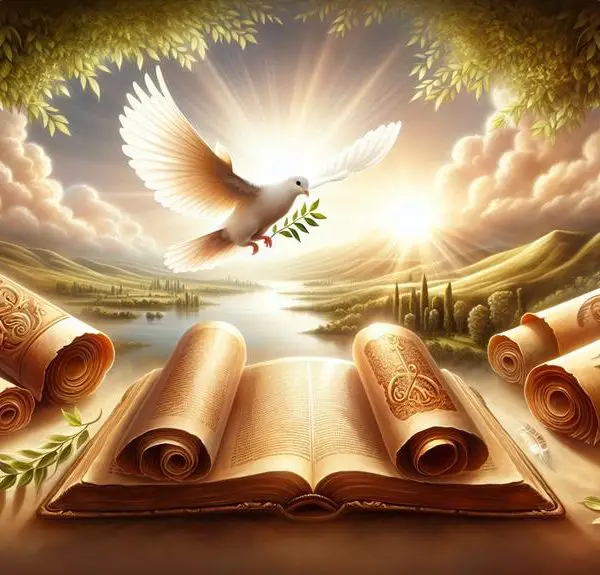
Sign up